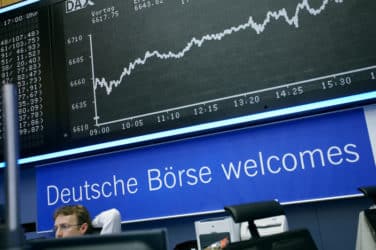Go baby go!
In a recent research note, DataTrek co-founder Nicholas Colas, who has been somewhat of a stock bull throughout 2019, remains keen on the sector after its stellar performance last year.
“We like US stocks most (expected total return of 12%), followed by Emerging Markets and EAFE stocks last,” Colas wrote in his note. “We believe 10-year Treasury rates will climb modestly and end the year at 2.3%. The dollar will weaken, growth (Tech, mostly) will outperform, and the Fed will keep rates unchanged but increase its balance sheet. Where we could be wrong: corporate debt levels are high and global consumer confidence is stagnant. Any shock will be hard to repair quickly.”
In looking ahead, Colas and Co. provided the following prognostications:
#1: S&P 500 target: 3,555
- This represents a 10% gain from the December 31 close of 3231.
- Not included: the index’s 1.7% yield.
#2: S&P 500 revenue and earnings growth in 2020: 5% apiece
- Single-digit earnings growth is better than 2019’s 0.3%.
- 2019 saw negative earnings leverage (revenue growth>earnings growth), but better top line growth in 2020 (5% versus 3.8% in 2019) should stabilize margins.
#3: The US 10-year Treasury bond will average a 2.2% yield in 2020 and end the year at 2.3%
- This is modestly higher than 2019’s average 10-year yield of 2.14%.
- These levels will be sufficient to keep yield curve-based recession indicators from signaling a near term economic contraction.
#4: The Federal Reserve will leave rates unchanged but increase the size of its balance sheet
- The Fed will not want to change rate policy in an election year unless it must respond to a clear and unforeseen negative event.
- At its 2019 nadir, the Fed’s balance sheet totaled $3.8 trillion. It has since expanded to $4.2 trillion (1/1/20 level) to ease stress in the repo market. The Fed will not risk a “taper tantrum” by removing this liquidity, but rather modestly expand its balance sheet through 2020 to ensure market stability.
Underlying all these points:
The US-China will conclude a Phase II trade deal by October 2020. It will not fully address the thorniest issues like intellectual property transfers, but with President Trump in full re-election mode he will certainly want another trade “win”.
Inflation, as measured by core CPE (the Fed’s preferred measure) will remain below 2% but trend modestly higher.
The US Presidential election will be between Mr. Trump and a centrist Democrat, most likely Joe Biden. Markets will not care who wins unless Democrats also retake the Senate (which we do not expect).
US real GDP growth will run 2.0% – 2.5% in 2020, the same as 2019; Eurozone growth will modestly reaccelerate to 1.4% – 1.6%.
The US dollar will weaken by 5% – 7% in 2020 as overseas economies (primarily Europe but also China) perform better. This move would take the DXY index back to where it was in early 2018, the last time markets believed in a global synchronized recovery.
“As far as investment positioning preferences, here is our take.”
#1: US large caps should outperform small caps.
- The S&P 500 has a larger Tech weighting than the Russell 2000 (31% including AMZN, GOOG and FB vs. 13.7%). Over half (56%) of large cap Tech’s revenues come from non-US sources so it will benefit from both better overseas growth and a weaker dollar.
- Small cap valuations move with high yield corporate bond spreads, which at 361 bp over Treasuries today have little room for further declines.
- The Russell has a larger weighting in Health Care than the S&P 500 (17.9% vs. 14.1%), a tough sector in an election year. It also has a larger dose of Financials (17.5% vs. 12.9%), and since we don’t see the yield curve steepening dramatically that’s a headwind.
#2: In order of 2020 returns, we like US stocks first, Emerging Market second, and EAFE (non-US developed economies) last.
- If our basic thesis outlined above is correct, 2020 fits a late cycle template where growth stocks will outperform value names. Our reasoning: markets move on earnings/cash flow surprises and those are more likely to come in areas where revenue growth is reaccelerating after a flat 2019.
- US large caps have the benefit of a large overweight to global Tech, as noted above. Communications (dominated by GOOG, FB and media like NFLX, CMCSA and DIS) and Consumer Discretionary (+50% in AMZN, HD, MCD, NKE and SBUX) make up another 20%.
- The MSCI Emerging Markets index also has notable Tech exposure (25%), albeit concentrated in more China-centric names like Alibaba (5.8%) and Tencent/Naspers (5.6%). If Financials weren’t 22% of MSCI EM we would like it a lot more…
- MSCI EAFE is a bit of mess when it comes to growth names. Tech is just 7% of the index (although what there is should do just fine), and Financials are 18%. If you think European financials/industrials are set to continue their late 2019 run, EAFE should do fine. That’s too spicy a bet for us, however.
But wait, there could be somethings that could nip any rally in the bud.
Colas states:
#1: US corporate balance sheets are brittle, with aggregate debt running at all time high levels (close to 50% of GDP). That’s fine as long as operating cash flow and margins remain robust, but no amount of Fed easing in a sudden downturn will magically fix suddenly contracting coverage ratios.
#2: The European Central Bank has a new chief in Christine Lagarde. While not superstitious, we do give credence to the idea that freshly installed central bank heads see an existential test in their first year or two. Greenspan had 1987’s market crash, Bernanke’s first 24 months included 2007, Draghi started in 2011’s Greek debt crisis, etc. For Lagarde, the challenge will be to somehow convince the Eurozone bond market that negative long-term rates are not the “right” price for these securities.
Put briefly, the real bear case for global risk assets is that the nothing can go seriously wrong without policymakers having to write entire new chapters in their playbooks. Like what, Colas asks?
“An oil shock that causes a recession, as we outlined recently,” Colas began. “Equity valuations discount not just the lack of a negative surprise, but a generally positive global economic outlook.”
He pointed out the following:
- A loss in consumer confidence, which has gone nowhere in the US or China for close to 3 years and is back to 2013 levels in the EU.
- Unforeseen problems with Brexit if it affects the Eurozone.
- Any economic shock in the first 4 months of 2020 will make progressive Democratic Presidential candidates look prescient and boost their chances at taking the White House (and possibly the Senate) in November.
- The current market structure for US financial assets (passive investing through ETFs, algorithmic market making) has come of age during a time of generally low volatility. A sudden shock will stress this system, with possibly unforeseen outcomes.
“Bottom line – everything has to go just so to deliver on our forecasts, but we’re OK with that.” Colas said. “Equity investing is an optimist’s game – always has been, always will be. Enough can go right to keep us in the bullish camp.”







